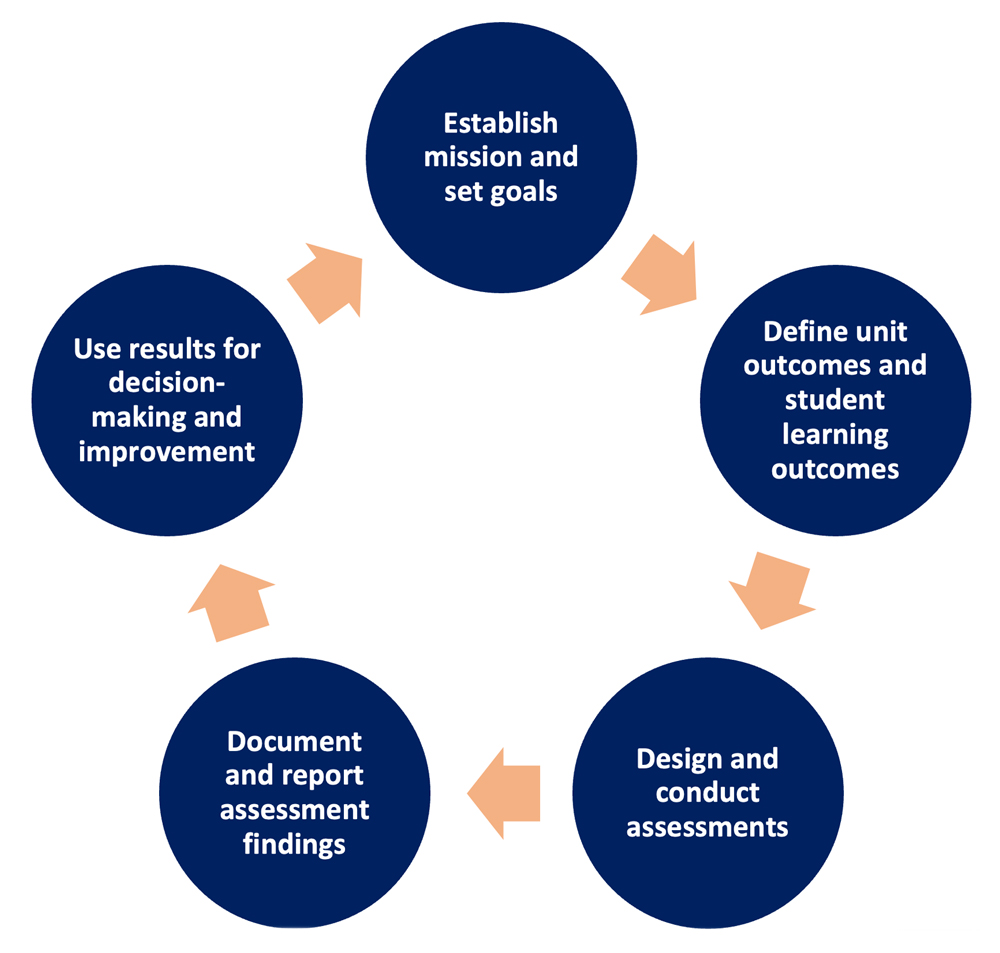Administrative and Educational Support (AES) Assessment
Overview
Assessment is a systematic process that shows whether goals are being met, and to what extent. According to Cumming and Miller (2017) assessment aims to:
- Establish clear, measurable, and expected outcomes;
- Ensure sufficient opportunities to achieve those outcomes;
- Gather evidence in a systematic manner to determine how well outcomes match expectations; and
- Use data obtained from the assessment to understand and improve the unit and student experience.
Collecting data to understand strengths and weaknesses is one of the main reasons that we engage in assessment activities and its application helps us to improve our institutional effectiveness. A carefully considered assessment plan enables Nassau Community College’s administrators and staff to identify areas of student needs and operational improvements. Once these needs and improvements are identified, AES units can discuss and identify the best strategies to improve student outcomes, ultimately improving student retention and completion.
It is important for Nassau Community College staff and administrators to actively lead and participate in the assessment process to receive its full benefits. Given that staff are intimately familiar with their unit’s or program’s mission, goals and outcomes, they are best equipped to develop appropriate measurement tools for assessment.
AES Assessment Framework
Nassau Community College’s primary impetus for conducting AES Assessment is for the continual improvement of the units at the forefront of creating and fostering meaningful experiences for our students. The Middle States Commission on Higher Education standards provides a guide for the AES assessment activities to be undertaken and has indicated in its standards that institutional assessment and periodic evaluation are integral to the institutional planning process and is central to demonstrating institutional effectiveness.
Assessment is about continuous improvement and making evidence-based decisions. At Nassau Community College (NCC), the ultimate purpose for engaging in AES assessment is to ensure we are delivering quality programs and services to our students. By utilizing systematic and ongoing processes of gathering, analyzing and using information from various sources, the College strives to improve student support services and student learning. The planning and assessment of non-academic units are essential aspects of the College's systematic process of ensuring effectiveness and fostering continuous, incremental improvement in all areas.
The assessment of AES units supports institutional effectiveness by demonstrating the degree to which NCC is achieving its mission through ongoing assessment and continuous improvement, as evidenced by:
- Annually tracking the progress made in achieving institutional and unit level goals;
- Assessing the attainment of the College’s strategic goals, student learning and program level goals
- Evaluating the quality of programs and services.
Throughout the academic year, AES units assess the data collected to determine the success of their initiatives. Units provide evidence of actual improvement of their processes or outcomes based on analysis of the results. Units also can assess student learning outcomes (SLOs), in their workshops and seminars. All results are documented in the assessment tool's work space for each unit. Based on the results, the unit may re-assess its goals for the following academic year.
AES assessment cycle at Nassau Community College at a glance.

Annual Assessment Themes
AES assessment is done annually with divisions and departments collecting data to measure student learning and/or success outcomes each year. AES units must articulate annual outcomes based on the strategic goals that are selected for focus, annually. Below is the AES assessment sequence and the accompanying strategic goal guiding the process.
- Academic Year 2024 - 2025: Academic Excellence and Student Support
- Academic Year 2025 - 2026: Student Persistence and Post-Completion Success
- Academic Year 2026 - 2027: Equitable Student Opportunities
- Academic Year 2027 - 2028: High School, Community, Business and Industry Partnerships
Assessment Plans
Assessment plans are written documents that serve as a blueprint for the unit’s assessment activities and is the first step in the continuous improvement process. The primary components of an assessment plan include:
- Unit’s mission statement (Aligned to College’s mission)
- Unit’s goals (Between 3-5)
- Unit success outcomes (Outcomes not directly related to student learning)
- Student Learning Outcome (SLO) (At least one outcome directly related to student learning; for student-facing units only)
- Data sources (Types of data to be collected/gathered for measuring outcomes; may be multi-year or single year)
- Findings (What was learnt from the data analysis)
- Action items (changes to process, policy or personnel that will be implemented as a result of assessment findings
Plans should include assignments of responsibility and schedules for action that include when and how often that action will be taken. Assessment plans will only lead to improvement if they are faithfully implemented. Thus, an effective assessment plan is feasible, both initially and to continue in an ongoing manner.
Timeline for Annual Assessment Activities
| March - May | Assessment preparation meeting between unit head and IESP. The unit's staff may be invited as well |
| June - July |
|
| August - September | Unit adds their assessment plan to the assessment tool |
| End of September - December |
|
| December - Janaury |
|
| February - April | Spring data collection occurs |
| May |
|

